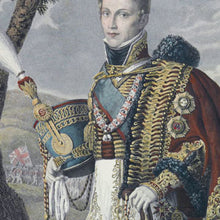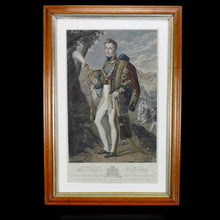Engraving - ‘Slender Billy’ Prince of Orange, 1816
- Regular price
- £1,100
- Sale price
- £1,100
- Regular price
-
- Unit price
- /per
Adding product to your cart
Overall: 82cm (32.2in) x 56cm (22in)
Colour etching and engraving. Full length portrait in uniform of Le Prince D’Orange by Etienne Frederic Lignon (1779-1833) after Joseph Dionysius Odevaere (1778-1830), published Paris, 1816. Contained in period maplewood frame.
Willem Frederick George, Prince of Orange, Prince of Orange, later William II, King of the Netherlands (1792-1849). The young Prince of Orange spent much of his youth in Britain, where his family was exiled. He was a popular figure with the British public, who nicknamed him 'Slender Billy'. After studying civil law at the University of Oxford, he entered the British Army, and in 1811, as an ADC at Wellington’s headquarters, and was allowed to observe several of Wellington's campaigns in the Peninsular War. In 1812 he was made an aide-de-camp to the Prince Regent and on 14 December 1813 promoted to major-general. His courage and good nature made him enhanced his public image. He returned to the Netherlands in 1813 when his father became sovereign prince, and in May 1814 succeeded Sir Thomas Graham as the highest-ranking officer of the British forces stationed there.
In 1814, he was promoted General and as such, he was senior officer of the Allied army in the Low Countries when Napoleon escaped from Elba. He relinquished command on the arrival of the Duke of Wellington, and served as the commander of the I Allied Corps at Quatre Bras (16 June 1815) and Waterloo (18 June 1815), where he was wounded in his left shoulder by a musket ball. Military historian William Siborne blamed many casualties suffered by the Allied forces during the Waterloo campaign to William's inexperience. However an inspection into the archives of Siborne by Dutch officer Francois de Bas in 1897 claimed to discover the ‘selective use of source’ and ‘numerous miscounts and untruths.






